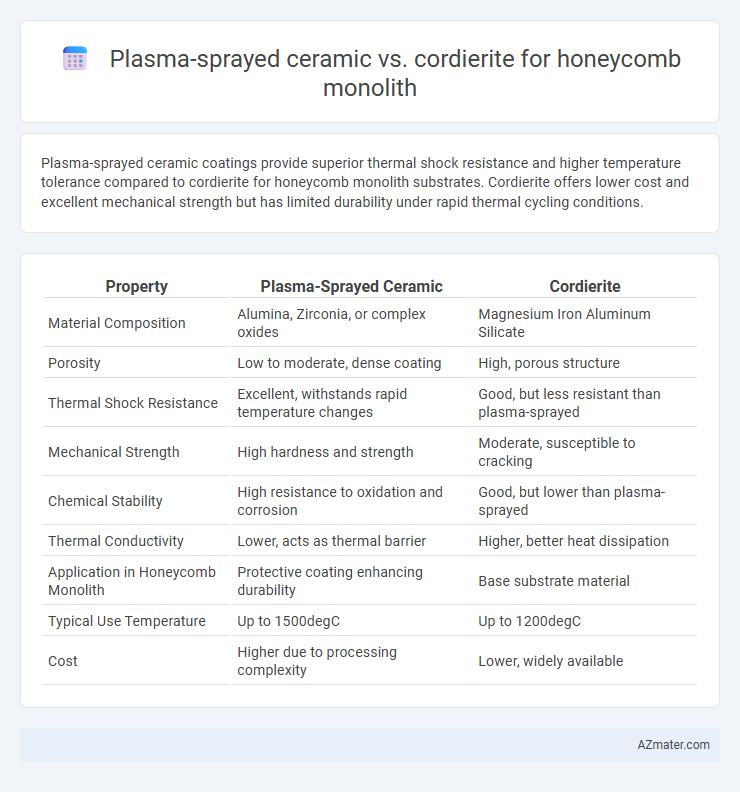Plasma-sprayed ceramic coatings provide superior thermal shock resistance and higher temperature tolerance compared to cordierite for honeycomb monolith substrates. Cordierite offers lower cost and excellent mechanical strength but has limited durability under rapid thermal cycling conditions.
Table of Comparison
| Property | Plasma-Sprayed Ceramic | Cordierite |
|---|---|---|
| Material Composition | Alumina, Zirconia, or complex oxides | Magnesium Iron Aluminum Silicate |
| Porosity | Low to moderate, dense coating | High, porous structure |
| Thermal Shock Resistance | Excellent, withstands rapid temperature changes | Good, but less resistant than plasma-sprayed |
| Mechanical Strength | High hardness and strength | Moderate, susceptible to cracking |
| Chemical Stability | High resistance to oxidation and corrosion | Good, but lower than plasma-sprayed |
| Thermal Conductivity | Lower, acts as thermal barrier | Higher, better heat dissipation |
| Application in Honeycomb Monolith | Protective coating enhancing durability | Base substrate material |
| Typical Use Temperature | Up to 1500degC | Up to 1200degC |
| Cost | Higher due to processing complexity | Lower, widely available |
Introduction to Honeycomb Monolith Substrates
Honeycomb monolith substrates serve as crucial components in catalytic converters and filtration systems, offering high surface area and low pressure drop for efficient exhaust treatment. Plasma-sprayed ceramic coatings enhance thermal durability, corrosion resistance, and mechanical strength compared to traditional cordierite substrates, which are widely used due to their excellent thermal shock resistance and low cost. Optimizing substrate material and coating techniques directly impacts the longevity and performance of emission control devices in automotive and industrial applications.
Overview of Plasma-Sprayed Ceramic Technology
Plasma-sprayed ceramic technology involves depositing molten ceramic particles onto a substrate like cordierite honeycomb monoliths, forming a dense, adherent coating with enhanced thermal and chemical resistance. This process enables tailored microstructures that improve durability and catalytic performance under high-temperature exhaust conditions. Compared to cordierite alone, plasma-sprayed ceramics provide superior resistance to thermal shock and corrosion, extending the lifespan of catalytic converters and diesel particulate filters.
Properties and Composition of Cordierite
Cordierite is a magnesium aluminum silicate ceramic known for its low thermal expansion coefficient, excellent thermal shock resistance, and high mechanical strength, making it ideal for honeycomb monolith structures in catalytic converters and diesel particulate filters. Its composition typically includes approximately 2MgO*2Al2O3*5SiO2, providing a stable crystalline structure that withstands rapid temperature fluctuations without cracking. In contrast, plasma-sprayed ceramics offer enhanced surface adhesion and density but generally lack the intrinsic thermal stability and low expansion characteristics inherent to cordierite monoliths.
Thermal Performance Comparison
Plasma-sprayed ceramic coatings on honeycomb monoliths exhibit superior thermal shock resistance and higher operational temperature limits compared to cordierite substrates, enhancing durability under rapid thermal cycling. Cordierite materials offer lower thermal conductivity and excellent thermal expansion compatibility, reducing stress-induced cracking but limiting peak temperature tolerance. Optimizing thermal performance depends on balancing plasma-sprayed ceramic's high-temperature resilience with cordierite's stability to achieve efficient heat management in catalytic and filtration applications.
Mechanical Strength and Durability
Plasma-sprayed ceramic coatings on honeycomb monoliths exhibit superior mechanical strength compared to cordierite, with enhanced resistance to thermal shock and mechanical wear under high-temperature conditions. Cordierite, while valued for its low thermal expansion and good thermal shock resistance, generally shows lower fracture toughness and is more prone to cracking under mechanical stress. Plasma-sprayed ceramics also provide improved durability by forming dense, adherent layers that resist spallation and erosion in aggressive environments, extending service life in catalytic converter applications.
Chemical Resistance and Stability
Plasma-sprayed ceramic coatings on honeycomb monoliths exhibit superior chemical resistance compared to cordierite, effectively withstanding aggressive environments with acids, alkalis, and high-temperature oxidation. Cordierite honeycomb structures offer excellent thermal stability and low thermal expansion, but their chemical resistance is limited against harsh industrial gases and corrosive chemicals. The enhanced chemical stability of plasma-sprayed ceramics ensures prolonged operational life and reliability in catalytic converters and filtration systems exposed to severe chemical conditions.
Manufacturing Processes and Scalability
Plasma-sprayed ceramic coatings on honeycomb monoliths allow for precise control in layer thickness and composition, enabling enhanced thermal and mechanical properties tailored to specific applications, with a manufacturing process that adapts well to complex geometries but requires specialized equipment and expertise. Cordierite monoliths, commonly produced via extrusion, benefit from a straightforward scalability and cost-effective mass production, offering excellent thermal shock resistance and structural integrity, though with less flexibility in modifying surface properties compared to plasma spraying. The choice between plasma-sprayed ceramics and cordierite hinges on the desired performance characteristics and manufacturing volume, where plasma spraying suits high-value, customized applications, and cordierite excels in large-scale, cost-sensitive production.
Cost-Effectiveness and Economic Considerations
Plasma-sprayed ceramic coatings exhibit superior thermal durability and erosion resistance compared to cordierite, reducing maintenance costs and extending the lifespan of honeycomb monoliths in high-temperature applications. Cordierite monoliths offer a lower initial cost and are favored in less aggressive conditions, making them economically viable where extreme thermal stability is not critical. Evaluating total lifecycle expenses, including material longevity and operational efficiency, reveals plasma-sprayed ceramics as cost-effective for long-term industrial use despite higher upfront investment.
Applications in Automotive and Industrial Catalysts
Plasma-sprayed ceramic coatings offer superior thermal shock resistance and durability compared to cordierite, making them ideal for honeycomb monolith substrates in automotive catalytic converters operating under high-temperature conditions. Cordierite's low thermal expansion and cost-effectiveness suit industrial catalysts where moderate temperatures and corrosion resistance are required. The choice between plasma-sprayed ceramics and cordierite significantly impacts catalyst efficiency, longevity, and performance in emission control systems across automotive and industrial sectors.
Future Trends and Innovations in Monolith Materials
Plasma-sprayed ceramic coatings on honeycomb monoliths offer enhanced thermal stability and corrosion resistance compared to traditional cordierite substrates, making them ideal for advanced catalytic converter applications. Emerging innovations focus on nanostructured plasma-sprayed layers to improve catalytic performance and durability under extreme exhaust conditions. Future trends emphasize hybrid materials combining plasma-sprayed ceramics with cordierite cores to optimize cost-efficiency and mechanical strength in automotive and industrial emission control systems.

Infographic: Plasma-sprayed ceramic vs Cordierite for Honeycomb monolith
 azmater.com
azmater.com